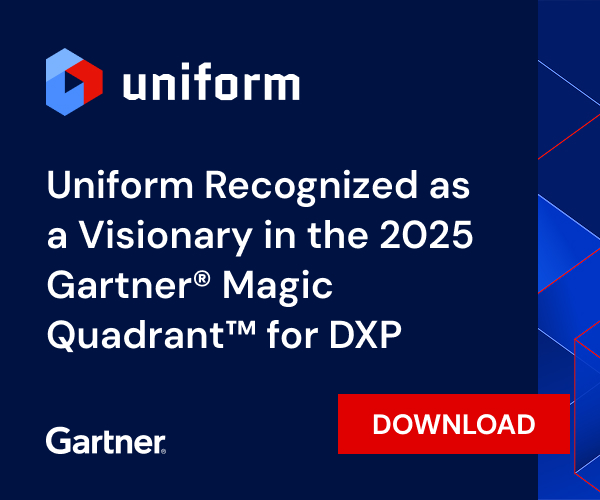Going composable with your technology project is like building a new home. Just as you would plan for future renovations, composability enables you to seamlessly adjust your
digital experiences as business needs evolve.
This was one of many insights shared by Sophia Zlatin, manager of marketing technology at
James Hardie, who spoke at our recent webinar, “
Capturing Composability: Insights from James Hardie.” Zlatin discussed the challenges and opportunities of building a website within a large multinational organization and the benefits of adopting a modular approach to creating fast, personalized customer experiences for a global audience.
In this post, we share some takeaways from the discussion, including how Uniform helped the building materials company assemble a diverse technology stack without overhauling their platform or sacrificing a fast, customer-centric experience.
As a digital marketer at a leading manufacturer of premium building products, Zlatin likens James Hardie’s composable journey to the different approaches for updating a home:
- Legacy systems: These represent the “rigid houses” that are difficult to update without replatforming and overhauling your entire architecture.
- Monolithic platforms: This “cobbled-together home” might feature lots of custom parts. But these components are pieced together with numerous plug-ins, resulting in a poor and clunky user experience.
- Composable digital experience platform (DXP): With a composable platform, your modular “LEGO house” is scalable, flexible, and easy to expand with new sections without disrupting the core architecture.
While some brands might opt for a traditional DXP or a highly customized solution with numerous “nooks and crannies,” expanding functionality using either option can lead to problems down the road.
Uniform’s composable DXP overcomes this challenge by enabling you to plug and play new capabilities as your technological needs change, complexity grows, and political or economic climates shift. This was a significant advantage for James Hardie, which needed to agilely scale functionality across multiple sites and new geographic markets.
“We don't have to
replatform every three to five years because we need this new functionality, and the old functionality is no longer working,” explained Zlatin.
“Also, we want it to be modular enough from a security, scalability, and flexibility perspective. And really make sure that as we need to evolve, add more features and functionality, and change our web strategy, we have all of these tools available … and we’re not beholden to one tool or platform.”
In a company as large as James Hardie, unifying its disparate data sources was key to gaining greater control over its digital footprint and progressing along its journey to a more flexible, composable stack.
“[James Hardie] has the typical tech debt challenges that most large companies have—many data sources across systems [and] all of our legacy data, which we have no control over from a web perspective,” said Zlatin. “It's many years of decisions in different departments without having the web customer experience in mind when those decisions are made.”
Zlatin pointed out that James Hardie’s progressive approach to digital transformation, combined with Uniform’s
no-code integration capabilities, enabled them to overcome significant tech debt and data fragmentation. By orchestrating
data from multiple sources with no code, digital teams could restructure their data in a way that was digestible for online audiences.
Moreover, Zlatin advises applying an 80-20 rule: setting aside 80 percent of your project time for restructuring back-end data. With Uniform, data updates are now automated, making a previously manual, labor-intensive task quick and seamless.
“It’s really user-friendly from an internal perspective, where we don't have to manually change anything. The data updates automatically.”
Becoming truly composable requires an upfront investment that can take considerable time and strategic planning. Still, the long-term advantages are well worth the effort.
Zlatin shared that while the initial build speed for the James Hardie website wasn’t faster, development sprints for a “house three” project post-launch became more agile and iterative.
“Once it’s built, those other changes are easier, smoother, more replicable, and more understandable because you're, again, playing with LEGO blocks rather than having to tear something down in order to build something new that doesn't quite fit.”
This modularization not only enabled the company to reduce development time but also minimized custom API development. Developers can work on and connect in-demand features using API-first integrations instead of combining technologies with custom glue code.
For example, the James Hardie team has enabled dynamic data
personalization based on user location and improved their digital asset management capabilities using Uniform’s codeless integration.
“With a
composable architecture, you can just migrate to a different platform,” said Zlatin. “Then, again, it's plug-and-play, like LEGO pieces. You detach one and attach the other, and it really helps you to not be locked into other platforms.”
Looking to deliver scalable, personalized campaigns that elevate your business and digital presence?
Request a demo to see how Uniform’s composable DXP helps digital teams reach their full potential.






.png&w=1080&q=90)
.png&w=1080&q=90)
.png&w=1080&q=90)